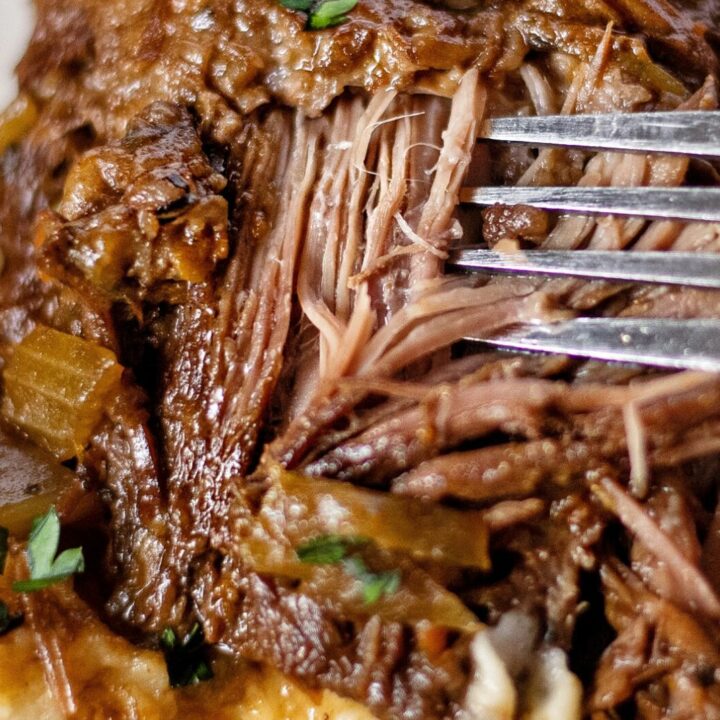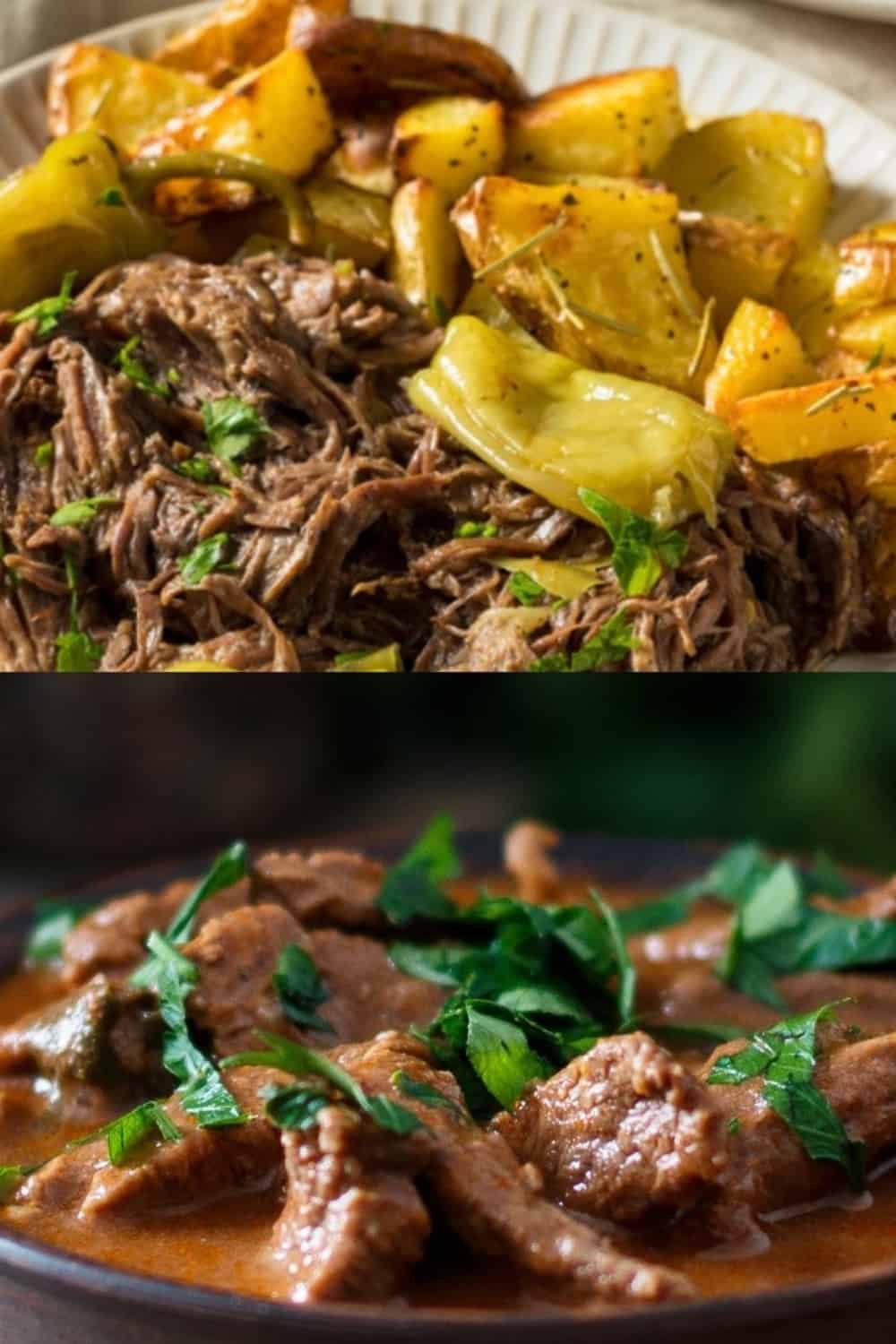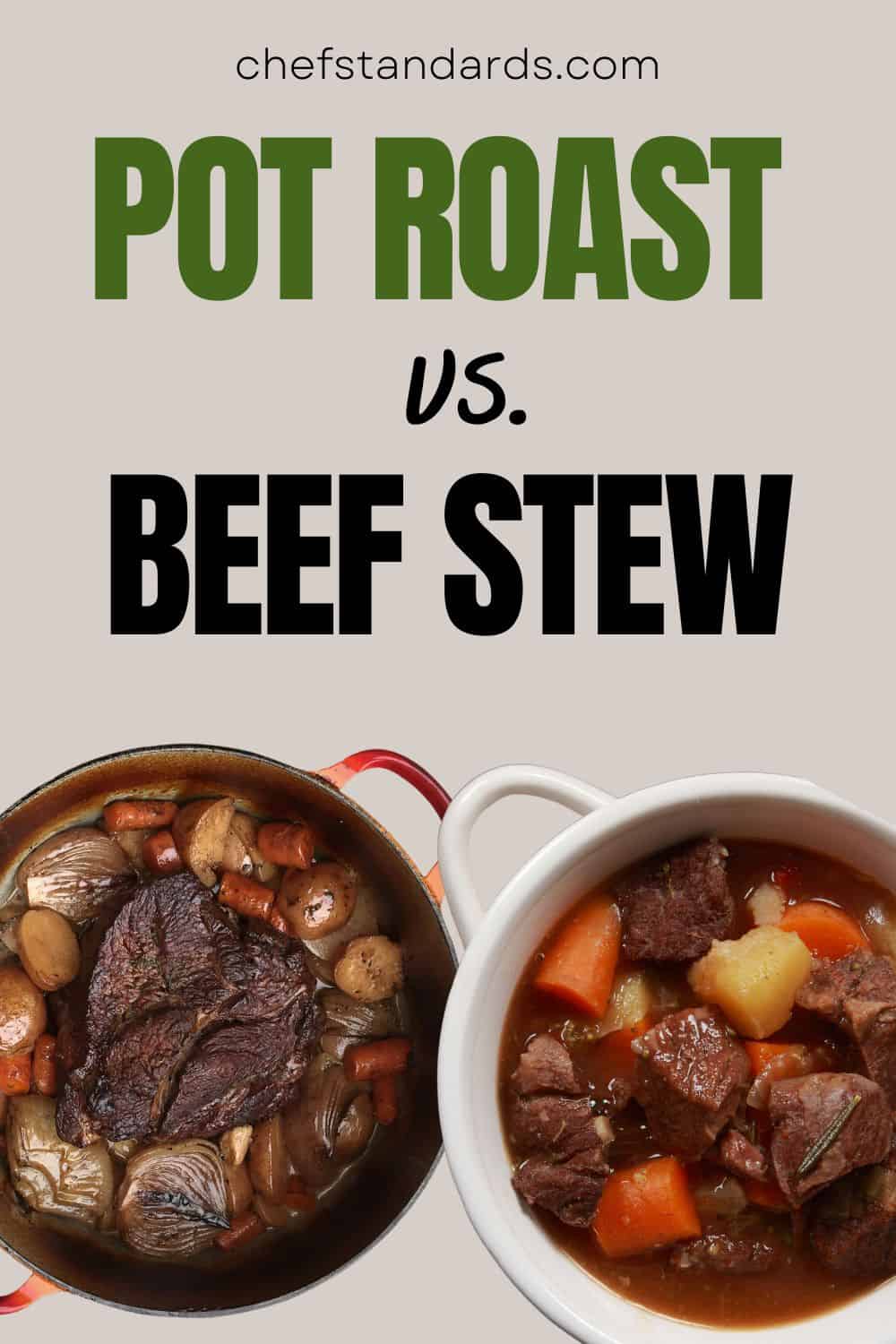If you are into comfort food that is at the same time delicious and nutritious, pot roast and beef stew are the perfect choices.
The combination of flavorful, tender meat and healthy veggies can make everyone’s taste buds happy.
However, when speaking about these two types of dishes, many people don’t even know the difference between them. And some even think that they are the same thing.
Although very similar, especially in terms of ingredients, pot roast and beef stew have some distinctive differences worth mentioning.
This article will reveal to you what those differences are, as well as some other interesting information about them.
First, What Is Pot Roast?
Pot roast is a very popular type of meat dish, especially here in the United States. Its main ingredient is a large cut of meat accompanied with some vegetables and a bit of gravy to keep it nice and juicy.
The most common type of meat used in pot roast is beef. However, you shouldn’t limit yourself since it can be quite delicious when chicken, turkey, or pork are used as well.
Aside from a good cut of meat, the trademark of pot roast is a slow way of cooking.
In Europe, particularly in Western European countries, slow-cooking meat in pots has been a common practice for centuries. The pot roast as we know it today likely evolved from these culinary traditions.
For example, in France, the dish “boeuf à la mode” is a classic version of a pot roast that involves slow-cooking beef with vegetables and wine.
Similarly, in Germany, the dish “Sauerbraten” features pot-roasted beef marinated in a mixture of vinegar, water, and spices.
In the United States, this food that starts with P became a popular dish during the 19th and 20th centuries. As settlers moved westward, they relied on slow-cooking techniques to make the most of their ingredients and create flavorful, satisfying meals.
Pot roast quickly became a staple in American home cooking, often associated with comforting family meals and Sunday dinners.
Recipe

Pot roast recipe
If you are curious about making a flavorful and hearty pot roast, take a look at this great recipe I have selected just for you. So, let's take a look.
Ingredients
- 3 to 4 pounds (1.4 to 1.8 kg) chuck roast or bottom round roast
- 2 tablespoons vegetable oil
- 1 large onion, chopped
- 3 to 4 carrots, peeled and cut into chunks
- 3 to 4 potatoes, peeled and cut into chunks
- 3 cloves garlic, minced
- 2 cups beef broth
- 1 cup red wine (optional)
- 2 tablespoons tomato paste
- 1 tablespoon Worcestershire sauce
- 2 sprigs fresh thyme
- 2 sprigs fresh rosemary
- 2 bay leaves
- Salt and black pepper to taste
Instructions
1. Preheat your oven to 325°F (160°C).
2. Season the chuck roast with salt and black pepper on all sides.
3. Heat the vegetable oil in a large Dutch oven or oven-safe pot over medium-high heat. Brown the roast on all sides until well-seared, approximately 3 to 4 minutes per side. Remove the roast from the pot and set it aside.
4. In the same pot, add the chopped onion and minced garlic. Sauté until the onion becomes translucent and the garlic becomes fragrant.
5. Add the tomato paste to the pot and cook for 1 to 2 minutes, stirring constantly.
6. Pour in the beef broth and red wine (if using). Stir well to scrape any browned bits from the bottom of the pot.
7. Stir in the Worcestershire sauce, thyme, rosemary, and bay leaves. Season with additional salt and black pepper to taste.
8. Return the browned roast to the pot, along with any accumulated juices. Add the carrots and potatoes around the roast.
9. Cover the pot with a lid and transfer it to the preheated oven. Allow the pot roast to cook for approximately 3 to 4 hours, or until the meat becomes tender and easily pulls apart when using a fork.
10. Once the pot roast is done, remove it from the oven. Carefully transfer the meat to a cutting board and let it rest for a few minutes.
11. Remove and discard the thyme sprigs, rosemary sprigs, and bay leaves from the pot. Skim off any excess fat from the cooking liquid.
12. Slice or shred the pot roast as desired. Serve it with the cooked vegetables and a generous amount of the flavorful cooking liquid as gravy.
What About Beef Stew?
Like with pot roast, the main ingredient of beef stew is beef itself. However, this time, those are smaller beef chunks. Unlike beef consomme (a type of beef soup), it is much thicker.
They are also accompanied by various vegetables, including potatoes, carrots, onions, beans, tomatoes, and peppers, as well as various spices and seasonings.
And not to forget, there is also a liquid in which all of these ingredients are slowly cooked and served in its gravy, resulting in a thick and chunky soup-like dish.
In Europe, stews have been a common cooking method for centuries. In medieval times, stews were popular among peasants and nobility alike. The slow-cooking process allowed the flavors to develop and the meats to become tender.
In the United States, beef stew became popular during the 19th and 20th centuries. As settlers moved westward, beef stew was a common dish prepared on the frontier.
It made use of available ingredients and allowed for a nourishing and satisfying meal. It became particularly popular during times of economic hardship, as it offered an affordable and filling option.

Beef Stew recipe
Here is the recipe for a healthy and flavorful beef stew:
Ingredients
- 2 pounds (900 grams) beef stew meat, cut into bite-sized pieces
- 2 tablespoons vegetable oil
- 1 large onion, chopped
- 3 cloves garlic, minced
- 4 carrots, peeled and cut into chunks
- 2 celery stalks, sliced
- 8 small potatoes, halved or quartered
- 1 cup frozen peas
- 4 cups beef broth
- 1 cup red wine (optional)
- 2 tablespoons tomato paste
- 2 bay leaves
- 1 teaspoon dried thyme
- Salt and black pepper to taste
- Chopped fresh parsley for garnish (optional)
Instructions
- Heat the vegetable oil in a large pot or Dutch oven over medium heat. Add the beef stew meat and brown it on all sides. Remove the meat from the pot and set it aside.
- In the same pot, add the chopped onion and minced garlic. Sauté until the onion becomes translucent and the garlic becomes fragrant.
- Add the tomato paste to the pot and cook for 1-2 minutes, stirring constantly.
- Pour in the beef broth and red wine (if using). Stir well to scrape any browned bits from the bottom of the pot.
- Return the browned beef to the pot. Add the carrots, celery, potatoes, bay leaves, and thyme. Season with salt and black pepper to taste.
- Bring the stew to a boil, then reduce the heat to low. Cover the pot and simmer for about 2 to 3 hours, or until the beef is tender and the flavors have combined.
- In the last 15 minutes of cooking, add the frozen peas to the stew and stir gently. This will allow them to cook through without becoming mushy.
- Once the beef stew is done, taste and adjust the seasoning if needed. Remove the bay leaves.
- Serve the beef stew hot in bowls. Garnish with chopped fresh parsley if desired.
What Do They Have In Common?
Since these two types of dishes are quite similar, I will first underline their similarities before acknowledging their key differences. So, let’s first take a look at what they have in common.
• Slow Cooking Method: Both of them require a slow cooking method because that is the best way to achieve tender and flavorful meat.
Namely, this allows the collagen in tougher cuts of meat to break down, resulting in a texture that melts in your mouth.
• Beef Is Their Main Ingredient: The main protein of both types of dishes is beef. Cuts such as English Roast, Pot Roast, or Chuck Roast can be used in both of them.
The main fact is that they both use cuts with more connective tissue that benefit from long, slow cooking to become tender and flavorful.
• Vegetables: Another similarity is the fact that they both incorporate veggies to add nutrition and flavor.
Common vegetables used in both dishes include carrots, onions, and potatoes. However, additional vegetables like celery, mushrooms, peas, or parsnips can also be added to enhance the flavors and textures.
• Aromatic Flavorings: Aromatic ingredients are one of the main ingredients in these two types of dishes.
Common flavorings include garlic, rosemary, parsley, and bay leaves, as well as the best bay leaf substitute, thyme. And they add depth and richness to the overall taste profile of the dish.
• Broth or Sauce: Both dishes involve the use of a liquid component to create a flavorful broth or sauce.
While the specific liquids may vary, both pot roast and beef stew utilize broths, stocks, or the unique flavor of the wine to provide moisture and contribute to the overall taste of the dish.
Pot Roast Vs Beef Stew: 6 Key Differences

Finally, here is the part you all have been waiting for. Although there are not many differences between these two types of dishes, there are some of the key ones worth knowing if you can’t decide which one to make for your next delicious meal.
1. Meat Size And Types Of Meat Cuts
One of the most noticeable differences between these two types of dishes is the size of their meats.
Namely, in pot roast, the meat cut remains whole as when purchased from the store.
It is a different story with beef stew as the cut of beef is sliced into bite-sized pieces and then incorporated into the dish.
Although various types of cuts can be added to both dishes, chuck roast, brisket, and rump roast are the main stars of pot roast.
On the other hand, ribeye and chuck roast are mostly used when making beef stew.
2. Adding Vegetables
Both types of dishes incorporate vegetables, including carrots, onions, potatoes, and so on.
However, you have to know that veggies are not typically cooked with pot roast, but rather added additionally for the purpose of presentation.
They are also mostly left uncut and served like that alongside meat and other ingredients.
It is a different story with beef stew, as vegetables are cooked alongside other ingredients. They actually play a huge role in the overall flavor profile of the dish and add to the thickness of the gravy.
Some of the most popular vegetables used for this purpose include carrots, potatoes, onions, and celery. Additional ingredients can include mushrooms, pears, and parsnips.
And of course, there are also flavorings that provide additional depth and flavor complexity, including herbs like thyme, bay leaves, and parsley.
3. Amount Of Gravy
One of the biggest differences between pot roast and beef stew is gravy.
When it comes to pot roast, there is very little or even no gravy at all. Namely, the meat produces enough liquid during the cooking process to keep it tender, but chefs discard even that liquid after the process.
It is a different story with beef stew as it is somewhat like soup, so gravy is a must and there is a lot of it present in beef stew.
4. Cook Method and Time
Pot roast is typically cooked by braising, which involves browning the meat on the stovetop, then slowly cooking it in a covered pot or Dutch oven or on the stovetop.
I also have to emphasize that it is often cooked with vegetables and a liquid (like broth or wine) for the purpose of keeping it moist and flavorful.
Beef stew, on the other hand, is generally cooked by simmering in a liquid over low heat for an extended period. It is often prepared in a pot on the stovetop or in a slow cooker.
When it comes to stewing liquid, it is usually a combination of broth, wine, or other flavorful liquids.
The cooking times also differ. Since pot roast incorporates large cuts of meat, it requires a longer cooking time for the meat to get tender.
Beef stew takes less time to cook because it involves small chunks of meat that take less time to get tender.
5. Nutrition
The nutritional profile of both types of dishes mainly depends on the exact recipe. However, there are some underlying facts that need to be discussed.
First, pot roast is typically made with tougher meat cuts. Those meat cuts are higher in fat compared to leaner cuts of beef.
Beef stew, on the other hand, can be made with various cuts of beef, including leaner cuts like stew meat or lean sirloin. Using leaner cuts reduces the overall fat content of the stew.
The cooking method also plays a role in this case. Pot roast is typically cooked by braising, which involves browning the meat and then simmering it in a liquid.
The cooking liquid may include broth and wine, which can add some additional calories and added alcohol content.
In contrast, beef stew is usually simmered in a liquid that consists of broth and seasonings. The stewing process allows the flavors to meld together and tenderizes the meat and vegetables.
Finally, the most obvious factor that influences nutrition is the amount of vegetables. You already know that beef stew incorporates more vegetables and that they cook together with the meat.
Vegetables bring in more vitamins, minerals, and dietary fiber, making it a more desirable option from a health standpoint.
6. Serving Recommendations
When enjoying both of these dishes, I always like to drink a glass of good red wine. For example, a Cabernet Sauvignon is a perfect match for pot roast because it complements the bold flavors perfectly.
On the other hand, Pinot Noir can be a great accompaniment for more subtle flavors of beef stew. All in all, no matter what red wine you choose, you really can not go wrong.
Aside from wine, you can also serve pot roast with roasted vegetables, side salad, or mashed potatoes.
When it comes to beef stew, it goes really well with rice, noodles, or some good old crusty bread.

